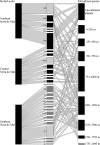Geographical and altitudinal distribution of Brachycephalus (Anura: Brachycephalidae) endemic to the Brazilian Atlantic Rainforest
- PMID: 27761312
- PMCID: PMC5068354
- DOI: 10.7717/peerj.2490
Geographical and altitudinal distribution of Brachycephalus (Anura: Brachycephalidae) endemic to the Brazilian Atlantic Rainforest
Abstract
Mountains of the Brazilian Atlantic Forest can act as islands of cold and wet climate, leading to the isolation and speciation of species with low dispersal capacity, such as the toadlet species of the genus Brachycephalus. This genus is composed primarily by diurnal species, with miniaturized body sizes (<2.5 cm), inhabiting microhabitats in the leaf litter of montane forests. Still, little is known about the geographical distribution, altitudinal range, and ecological limits of most Brachycephalus species. In this study, we review the available data on the geographical and altitudinal distribution of Brachycephalus based on occurrence records compiled from literature and museums, both for the genus as a whole and separately for the three recently proposed groups of species (ephippium, didactylus, and pernix). The final ensemble dataset comprised 333 records, 120 localities, 28 described species, and six undescribed ones. Species were recorded in six relief units, the richest of which being the Serra do Mar, with 30 species. When the Serra do Mar is subdivided into three subunits, Northern, Central and Southern Serra do Mar, the number of species increase from north to the south, with records of six, nine, and 16 species, respectively. We were able to estimate the extent of occurrence of nearly half of the described species, and the resulting estimates indicate that many of them show remarkably small ranges, some of which less than 50 ha. Brachycephalus species are present from sea level to roughly 1,900 m a.s.l., with the highest richness being found between 751 and 1,000 m a.s.l. (21 spp.). The species with the broadest altitudinal range were B. didactylus (1,075 m) and Brachycephalus sp. 1 (1,035 m), both in the didactylus group, and B. ephippium (1,050 m), of the ephippium group. The broadest altitudinal amplitude for species of the pernix group was recorded for B. brunneus (535 m). The lowest altitudinal records for the pernix group were at 845 m a.s.l. in the state of Paraná and at 455 m a.s.l. in the state of Santa Catarina. The altitudinal occurrence in the pernixspecies group seems to decrease southward. Syntopy between species is also reviewed.
Keywords: Cloud forest; Extent of occurrence; Highlands; Relief units; Species group; Syntopy.
Conflict of interest statement
Marcio Pie is an Academic Editor for PeerJ. Sérgio A.A. Morato is employed by STCP Engenharia de Projetos Ltda.
Figures




References
-
- Abegg AD, Ortiz FR, Rocha B, Condez TH. A new record for Brachycephalus nodoterga (Amphibia, Anura, Brachycephalidae) in the state of São Paulo, Brazil. Check List. 2015;11 doi: 10.15560/11.5.1769. Article 1769. - DOI
-
- Almeida FFM de, Carneiro C dal R. Origem e evolução da Serra do Mar. Revista Brasileira de Geociências. 1998;28:135–150.
-
- Almeida-Santos M, Siqueira CC, Van Sluys M, Rocha CFD. Ecology of the Brazilian flea frog Brachycephalus didactylus (Terrarana: Brachycephalidae) Journal of Herpetology. 2011;45:251–255. doi: 10.1670/10-015.1. - DOI
-
- Alves ACR, Ribeiro LF, Haddad CFB, Reis SF dos. Two new species of Brachycephalus (Anura: Brachycephalidae) from the Atlantic Forest in Paraná State, southern Brazil. Herpetologica. 2006;62:221–233. doi: 10.1655/05-41.1. - DOI
-
- Alves ACR, Sawaya RJ, Reis SF dos, Haddad CFB. New species of Brachycephalus (Anura: Brachycephalidae) from the Atlantic Rain Forest in São Paulo State, Southeastern Brazil. Journal of Herpetology. 2009;43:212–219. doi: 10.1670/0022-1511-43.2.212. - DOI
LinkOut - more resources
Full Text Sources
Other Literature Sources
Miscellaneous

